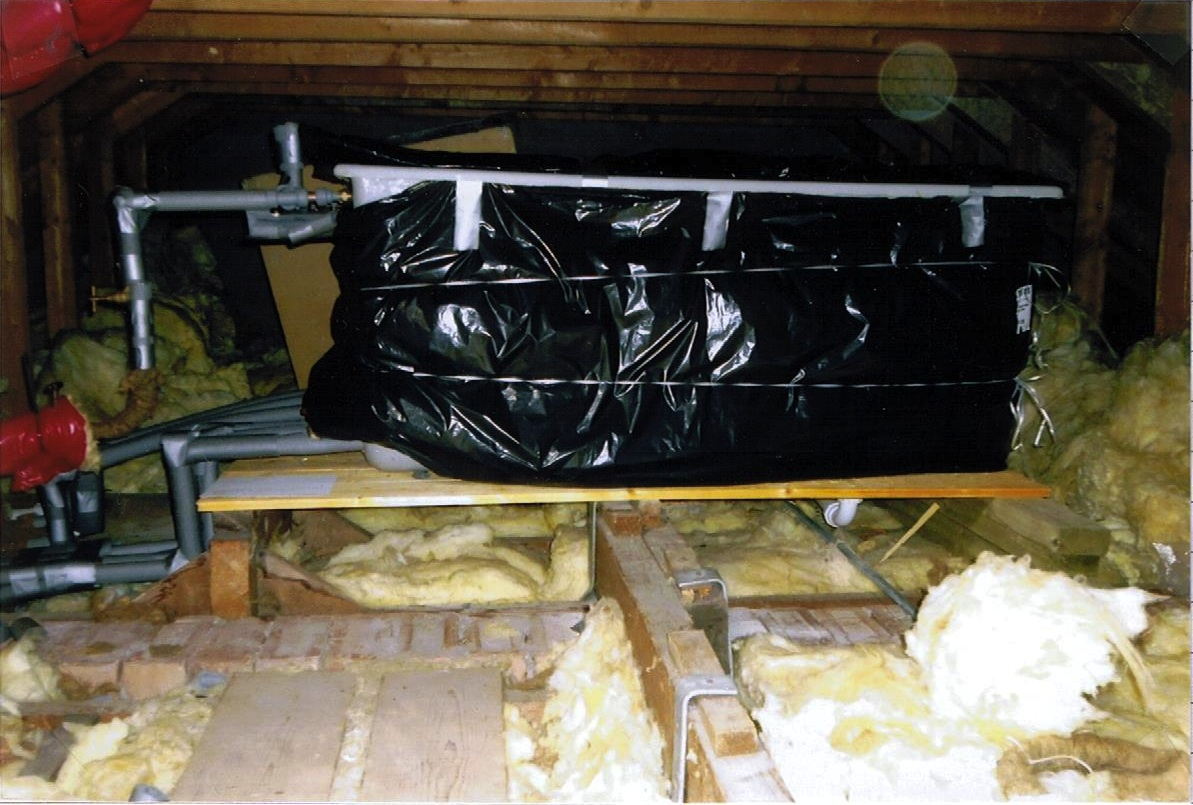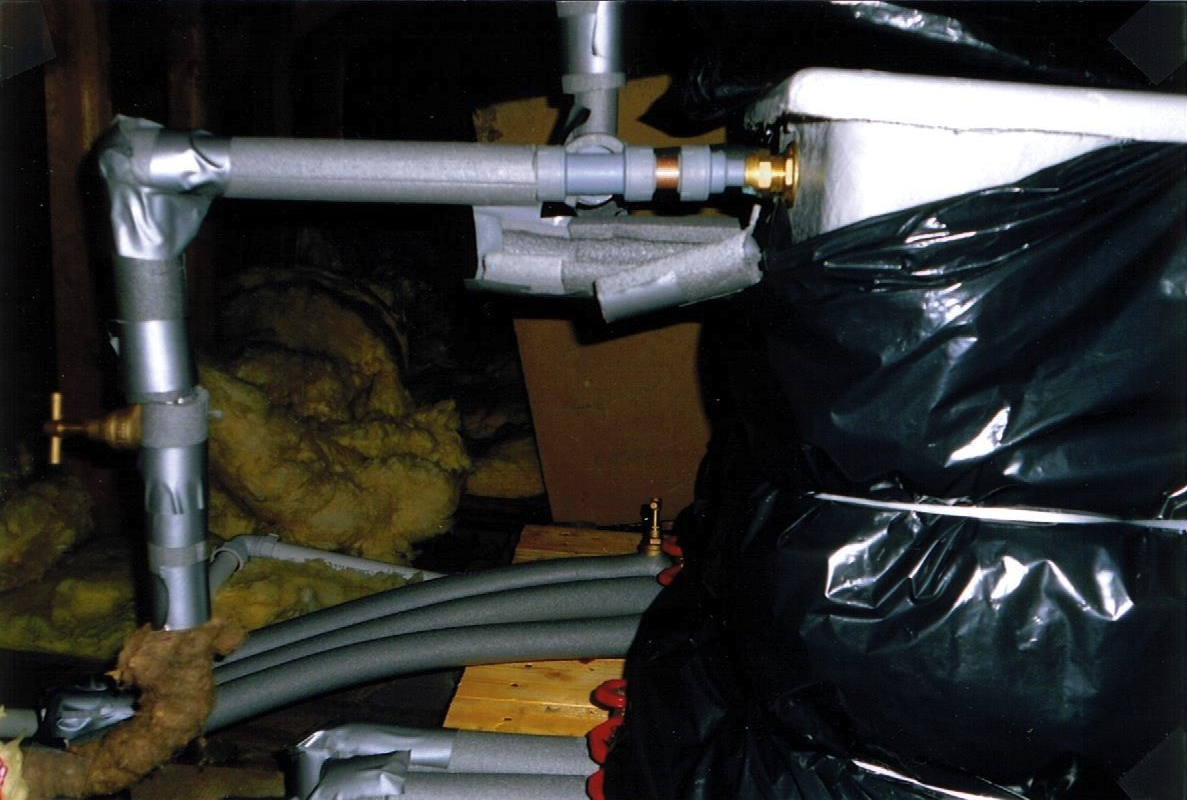Attic cistern thermal insulation enclosure Defects
GBE > Encyclopaedia > Code > Defects > G#1041 N#1058
Attic cistern thermal insulation enclosure Defects
About:
I was sent a snail mail letter asking for some advice on how to improve frost protection to the cisterns in the attic over a flat in a block of flats See Fig. 1 & Fig. 2
Cold water storage cisterns
(Otherwise know as water tank, not to be confused with Water Closet cistern)
- Usually located in the attic of houses and bungalows or top floor flats
- Sit on a platform of timber framing and timber boarding above the ceiling joist construction
- Take mains pressure water via a ball float valve into storage at height
- Provide low-pressure gravity-fed cold water to supply and top up domestic hot water and heating systems
- Provide low-pressure gravity-fed cold water supply to basins, WC cisterns, gravity fed showers,
- Provide low-pressure gravity-fed hot water supply to hot taps at basins, baths, and sinks and to showers and two pipe supply washing machine and dish washers
- Provide low-pressure gravity-fed supply to appliances in the event of temporary mains water failure or mains water cut off
- Cold water direct form the mains may alternatively go direct to Sink, Basin, WC cisterns and showers and washing machined and dish washers
- Usually two separate cold supply tanks one to domestic hot water system the other for heating feed and expansion for the heating system, it being smaller
- There are many BS British Standards for cistern manufacture in many materials
- There are BS for the ball float valve
- There is a Code of Practice for the low pressure gravity fed cold water supply systems
- There is a Code of Practice for domestic heating systems
BRE Evidence of BRM Failures
- BRE = Building Research Establishment
- BRM = Breathable Roofing Membranes
- Evidence based on 3-4 Failures
- There are many contributing factors
- One being open water tanks, no lids.
- Heated from below as intended to avoid freezing in winter.
- Warmed water released water vapour to cold attic air in winter
- Warm attic encouraging stored water to raise in temperature and release moisture vapour to warm attic in summer
- Excessive moisture vapour added to roof void.
- BRM not capable of releasing sufficient moisture vapour.
Blocks of flats
- In older low-rise blocks of flats with pitched roofs, each flat gets its own cistern
- The top floor flat has all the flats cisterns above its ceiling.
- In the event of failure of any cistern the top floor flat suffers first
- Newer flats usually have combined cold water cistern and hot water cylinder in an airing cupboard within the flats
Attics
- Provide height above the house or flat to accommodate a platform supporting the cisterns, the pipes, the cisterns and thermal insulation
- Also provide storage space for infrequently used or archived possessions of the occupant below the ceiling
- Attics enable the cistern to be high enough above the shower to provide enough ‘head’ for gravity feed to ensure the shower has adequate flow
- Get hot in summer by solar radiation warming the roof tiles or slates that then re-radiate the heat inwards to warm the air and the attic construction and stored contents
- Get cold in winter by the absence of solar radiation allowing the attic space to cool encouraged by cross ventilation eaves to eaves.
- PS
- Are ventilated at the eaves, more recently also vented at the ridge and within the slopes with special tiles
- Permit cross flow of external condition fresh air through the eaves, across the attic and out through the eaves
- Cross flow of fresh air helps minimise the build up of moisture vapour that could lead to condensation, rot and structural damage
- Bats, birds and insects can enter the attic and some make nests or roosts, sheltered from wind and precipitation and benefiting from solar heating
- Insect grilles are important to prevent ingress of potentially harmful insects
- Bats are protected species any form of disturbance can lead to a £5000 fine per bat.
Thermal Insulation
- Is used to protect the cisterns from the cold of winter to prevent icing of the stored water
- Is used to protect the pipes: mains cold feed, gravity feed to domestic cold water, gravity feed to domestic heating, overflow pipes to exterior;
- Is used to protect against freezing, expansion, frost damage and potential leakage
- Could also protect the cistern from warming in summer
- Needs to continue the ceiling insulation up the sides all round and over the top of the cisterns and the pipes
- Is not normally needed below the cistern to allow heat from the space below the ceiling to warm the cistern from below to help protect from winter cold
- Is ideally continuous from the ceiling insulation to the cistern insulation to prevent the heat from below just escaping into the attic and warming the planet.
- The B&Q video http://www.youtube.com/watch?v=MlRD9301_b8 shows no solution for this.
- There are no purpose made insulation for this but extra ceiling insulation up to the underside of the platform and passing below the position of the cistern wrap, should do the job nicely
- Cistern insulation is ideally in two parts: so the top can be lifted without disturbing the sides
- Is usually applied to the pipes separately
- Needs to be continuous without gaps, especially at changes of direction and at valves
- Taping over gaps is not as effective as insulating the gaps
- Taping of joints is important to reduce risk of heat loss through gaps if the insulation moves
- Needs to insulate against thermal conduction heat loss: most insulation types do this
- Needs to insulate against thermal radiation heat gains: many insulation types do not do this
- PS High decrement delay thermal insulation materials include:
- Dense wood fibre board
- medium density wood fibre
- cellulose fibre/flake (recycled newspaper)
- cellular glass ‘Foamed glass’
- There are no standards for cistern thermal insulation
- PS Historically it was made up on site to suit, a labour intensive an often inadequate job
- Today there are products available on the market purpose made for the job but matching the size of the insulation to the size of the cistern is important
- Usually comes with one piece to wrap around the sides of the cistern, to be trimmed around the pipes, with strings to hold it in place, reduce slump and resist against collapse, and the top to fit between the side wrap.
- The strings if too tight can reduce the effectiveness of the insulation
- The thickness of the insulation should ideally be the same as the ceiling insulation thickness
- PS 250-300 mm. if using a mineral fibre insulation: Stone, ‘Rock’, Glass or Slag.
- PS 300-400 mm. if using high decrement insulation (see list above)
- Thin insulation may well slump within the polyethylene sleeve leaving the cistern unprotected from frost risks towards the top where the insulation is thinnest or missing
- PS Historically pipe insulation was hessian like bandages wrapped around the pipe, very slow labour intensive, wholely inadequate, rarely comprehensive and completion avoided because risk of being checked is very low in domestic property.
- PS Today pre-made extruded tubes of insulation is available, easier to install, still needs attention to detail at changes of direction and still inadequate at taps and valves, generally inadequate thickness to be as effective as its needs to be on low to zero energy building.
Retrofitting
- If you suffer from any of the problems described above you want a solution
- My proposals would include:
- Repair the existing solution to improve its performance
- Add to the existing to solve its local problems to improve its overall performance
- Remove the existing and replace with a competent solution
- Add a competent solution leaving the existing in place
- My best solution is to leave all the existing and enclose the whole cistern, insulation and pipes with a new enclosure:
- It is reliant upon the existing platform being wider and longer that the stuff that sits on top to support the enclosure
- Measure the existing platform and the existing cistern pipes and insulation so you can make the enclosure on the ground, preassemble, dismantle, then bring the parts to the attic to reassemble.
- Remember to check the size of the attic hatch size and the maximum diagonal dimension, because the parts have to go through the hatch to get them up there to be able to assemble the enclosure
- Use a rigid insulation board made of dense wood fibre insulation to protect from the radiant heat of summer in addition to the winter heat loss.
- Wood fibreboard is stiff enough to be stable and not slump and strong enough to be assembled with nails, screws or dowels and strings or straps.
- Work out the best way to assemble the boards that will be easy to carryout in the attic
- The boards are available in numerous thicknesses including 50 and 100 mm. the enclosure is ideally 300 mm. thick but could be reduced by the thickness of the existing insulation if it is free of gaps
- This may need to be reinforced by reclaimed, UKWAS or FSC certified temperate softwood framing if necessary, use as little framing as practical to reduce thermal bridging
- Make sure the framing sits on the platform but the insulation can over sail the platform
- PS Cut the boards close to fit neatly around pipes and if you cannot cut accurately make the holes larger and use compressible insulation to fill the gaps.
- Boards are available from numerous green builders merchants, but they are few and far between but worth the effort to find.
- GBE Suppliers (Navigation) G#610 N#631
© GBE GBC GRC GBL NGS ASWS Brian Murphy aka BrianSpecMan ***
5th August 2013 – 14th October 2023
Attic cistern thermal insulation enclosure Defects
Images:

Fig. 1 Inadequately insulated attic cistern with insulation below platform

Fig. 2 Gaps in insulated pipes insulation hanging in the air and exposed cistern
© GBE GBC GRC GBL NGS ASWS Brian Murphy aka BrianSpecMan ***
5th August 2013 – 14th October 2023
Attic cistern thermal insulation enclosure Defects
See Also:
GBE Video
- Insulation
- Is ideally continuous from the ceiling insulation to the cistern insulation to prevent the heat from below just escaping into the attic and warming up the planet
- The B&Q video shows no solution for this.
- http://www.youtube.com/watch?v=MlRD9301_b8
- There are no purpose made insulation for this but extra ceiling insulation up to the underside of the platform and passing below the position of the cistern wrap, should do the job nicely
GBE Manufacturers
GBE Suppliers
GBE Systems
- StoreFloor G#13287
GBE Jargon Buster
- Access
- Care
- Care v Skills
- Decking
- Decrement Delay
- Conductivity
- Conductivity Thermal Insulation
- K43 Raised Storage/Access Systems
- Radiation Thermal Insulation
- Raised Storage/Access Systems
- Skills
- Skills v Care
- Solar Radiation
- Storage
- Thermal Bridge
- Thermal By-pass
- Walkway
© GBE GBC GRC GBL NGS ASWS Brian Murphy aka BrianSpecMan ***
5th August 2013 – 14th October 2023

